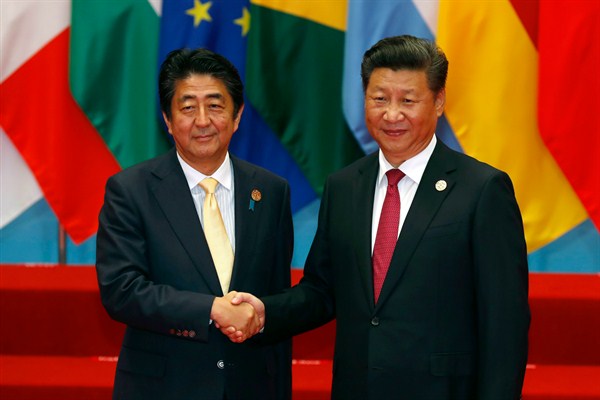Last week, at a meeting on the sidelines of the Eastern Economic Forum in the Pacific port of Vladivostok, in far eastern Russia, Japanese Prime Minister Shinzo Abe and Chinese President Xi Jinping agreed to improve their long-strained bilateral relationship. It was their seventh meeting since late 2012, though each one has been on the sidelines of international gatherings, rather than full-fledged bilateral visits. The reason is that, up until recently, China has been hesitant to court Japan and restore traditional high-level exchanges through state visits, especially since their relations fell off a cliff seven years ago due to tensions over the disputed Senkaku Islands—referred to as the Diaoyu by China—in the East China Sea.
This dynamic of intractability, however, has been changing gradually. Earlier this year, Japan hosted Chinese Premier Li Keqiang for a bilateral visit, alongside a separate trilateral summit with South Korean President Moon Jae-in. While Li was in Japan, Abe made extra efforts to demonstrate Tokyo’s desire to bring relations with Beijing back to a pragmatic middle ground; he even accompanied Li during his follow-on trip to Japan’s northern island of Hokkaido. Li’s visit ushered in a series of upcoming diplomatic engagements between the two sides as they mark the 40th anniversary of the signing of the Treaty of Peace and Friendship that formally ended their World War II-era hostilities. The next big step is Abe’s planned visit to China next month, a standalone summit with Xi reportedly set for Oct. 23, the anniversary date of the treaty’s signing.
During their meeting in Vladivostok, Xi and Abe both nodded to the October summit and the mutual thaw in ties. Abe arguably struck the more positive tone, saying the two sides “reconfirmed a common awareness of deepening friendship and cooperation” and stressing his intention to use the momentum to “establish a basis for peace and prosperity in Northeast Asia.” In addition to Abe’s visit to China next month, Xi is slated to make his first presidential trip to Japan next year for the Group of 20 summit, which Japan is hosting.

